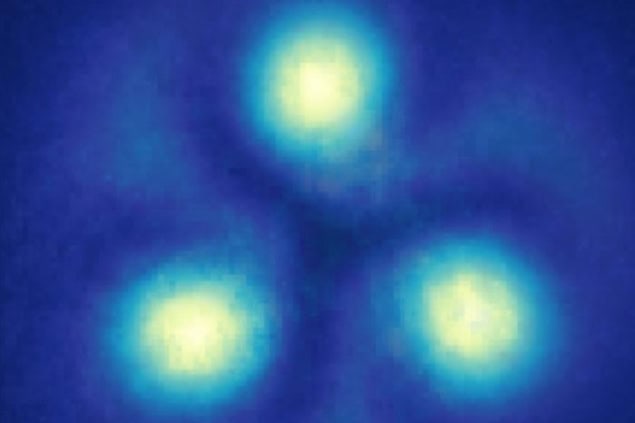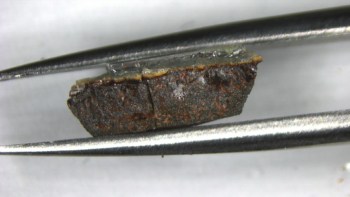
Quantized vortices – one of the defining features of superfluidity – have been seen in a supersolid for the first time. Observed by researchers in Austria, these vortices provide further confirmation that supersolids can be modelled as superfluids with a crystalline structure. This model could have variety of other applications in quantum many body physics and Austrian team now using it to study pulsars, which are rotating and magnetized neutron stars.
A superfluid is a curious state of matter that can flow without any friction. Superfluid systems that have been studied in the lab include helium-4; type-II superconductors; and Bose–Einstein condensates (BECs) – all of which exist at very low temperatures.
More than five decades ago, physicists suggested that some systems could exhibit crystalline order and superfluidity simultaneously in a unique state of matter called a supersolid. In such a state, the atoms would be described by the same wavefunction and are therefore delocalized across the entire crystal lattice. The order of the supersolid would therefore be defined by the nodes and antinodes of this wavefunction.
In 2004, Moses Chan of the Pennsylvania State University in the US and his PhD student Eun-Seong Kim reported observing a supersolid phase in superfluid helium-4. However, Chan and others have not been able to reproduce this result. Subsequently, researchers including Giovanni Modugno at Italy’s University of Pisa and Francesca Ferlaino at the University of Innsbruck in Austria have demonstrated evidence of supersolidity in BECs of magnetic atoms.
Irrotational behaviour
But until now, no-one had observed an important aspect of superfluidity in a supersolid: that a superfluid never carries bulk angular momentum. If a superfluid is placed in a container and the container is rotated at moderate angular velocity, it simply flows freely against the edges. As the angular momentum of the container increases, however, it becomes energetically costly to maintain the decoupling between the container and the superfluid. “Still, globally, the system is irrotational,” says Ferlaino; “So there’s really a necessity for the superfluid to heal itself from rotation.”
In a normal superfluid, this “healing” occurs by the formation of small, quantized vortices that dissipate the angular momentum, allowing the system to remain globally irrotational. “In an ordinary superfluid that’s not modulated in space [the vortices] form a kind of triangular structure called an Abrikosov lattice, because that’s the structure that minimizes their energy,” explains Ferlaino. It was unclear how the vortices might sit inside a supersolid lattice.
In the new work, Ferlaino and colleagues at the University of Innsbruck utilized a technique called magnetostirring to rotate a BEC of magnetic dysprosium-164 atoms. They caused the atoms to rotate simply by rotating the magnetic field. “That’s the beauty: it’s so simple but nobody had thought about this before,” says Ferlaino.
As the group increased the field’s rotation rate, they observed vortices forming in the condensate and migrating to the density minima. “Vortices are zeroes of density, so there it costs less energy to drill a hole than in a density peak,” says Ferlaino; “The order that the vortices assume is largely imparted by the crystalline structure – although their distance is dependent on the repulsion between vortices.”
Unexpected applications
The researchers believe the findings could be applicable in some unexpected areas of physics. Ferlaino tells of hearing a talk about the interior composition of neutron stars by the theoretical astrophysicist Massimo Mannarelli of Gran Sasso Laboratory in Italy. “During the coffee break I went to speak to him and we’ve started to work together.”

The return of supersolids
“A large part of the astrophysical community is convinced that the core of a neutron star is a superfluid,” Ferlaino says; “The crust is a solid, the core is a superfluid, and a layer called the inner crust has both properties together.” Pulsars are neutron stars that emit radiation in a narrow beam, giving them a well-defined pulse rate that depends on their rotation. As they lose energy through radiation emission, they gradually slow down.
Occasionally, however, their rotation rates suddenly speed up again in events called glitches. The researchers’ theoretical models suggest that the glitches could be caused by vortices unpinning from the supersolid and crashing into the solid exterior, imparting extra angular momentum. “When we impose a rotation on our supersolid that slows down, then at some point the vortices unpin and we see the glitches in the rotational frequency,” Ferlaino says. “This is a new direction – I don’t know where it will bring us, but for sure experimentally observing vortices was the first step.”
Theorist Blair Blakie of the University of Otago in New Zealand is excited by the research. “Vortices in supersolids were a bit of a curiosity in early theories, and sometimes you’re not sure whether theorists are just being a bit crazy considering things, but now they’re here,” he says. “It opens this new landscape for studying things from non-equilibrium dynamics to turbulence – all sorts of things where you’ve got this exotic material with topological defects in it. It’s very hard to predict what the killer application will be, but in these fields people love new systems with new properties.”
The research is described in Nature.



